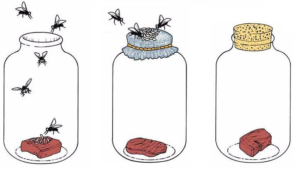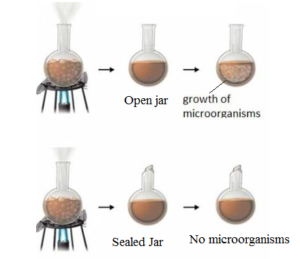The planet earth came into existence sometime between 4 and 5 billion years ago. Life evolved on planet earth about 3.5 billion years ago. The origin of life on the earth is also called photobiogenesis. Now it is clear that the life came into existence from the non-living substances.
Theory of Special Creation of Origin of Life:
This theory in biology was proposed by Spanish monk Father Sudrez. According to this oldest theory, all the different forms of life that occur today on planet earth, have been created by God, the Almighty or some supernatural power. This idea is found in the ancient scriptures of almost every religion.
According to Christianity, God has created the whole world in six days. The heaven and the earth were created on the first day, sky and sea on the second day, drylands and plants on the third day, sun, moon and stars on the fifth day and all the animals including human and beasts on the sixth day. He created the first man Adam from clay and the first woman Eve from the 12th rib of Adam.
According to Hinduism, God of creation is Brahma. He created different forms of life from his body.
This theory is a purely religious concept and has no scientific explanation or practical evidence.
Theory of Catastrophism of Origin of Life:
This theory was given by Georges Cuvier. It is a modification of the theory of special creation. According to this theory, there have been several creations of life by God, each preceded by a catastrophic event due to some kind of geological disturbance. Each catastrophe completely destroyed the existing life and new life is created by God again. Each new creation consisted of life forms different from that of previous ones. This theory has no practical evidence.
Cosmozoic Theory (Panspermia Theory) of Origin of Life:
This idea was proposed by Richter in 1865 and supported by Arrhenius (1908). According to this theory, life has reached the planet Earth from other heavenly bodies such as meteorites, in the form of highly resistant spores of some microorganisms. The spores of some microorganisms are called cosmozoa or panspermia because they are preserved inside meteorites coming to the earth from the outer space. These meteorites struck the barren earth to release the cosmozoa and they developed into different creatures on the earth. This theory lacks evidence.
Theory of Eternity of Origin of Life:
According to this theory, life existed in the past and will continue to exist forever. It neither has the beginning nor end. Throughout its existence life changed in form. This theory fails to explain where and how the life came on this earth.
Theory of Spontaneous Generation:
This theory is also known as theory of abiogenesis or the theory of auto-biogenesis of origin of life. This theory was proposed by Greek philosophers (600 B.C.) and supported by Aristotle (384-322 BC). This theory assumed that living organisms could arise suddenly and spontaneously from a non-living matter.
Aristotle believed that dead leaves falling from a tree into a pond would transform into fishes and those falling on soil would transform into worms and insects. He also believed that some insects develop from morning dew and rotting manure. maggots from flesh, tapeworm from animal excreta, butterflies from cheese.
Von Helmont said that he had prepared a ‘soup’ from which he could spontaneously generate rats. The ‘soup’ consisted of a dirty shirt soaked in water with a handful of wheat grains for 21 days.
The idea of spontaneous generation was popular almost until the seventeenth century. Many scientists like Descartes, Galileo, and Helmont supported this idea. This theory was disproved by Fransisco Redi, (1665), Spallanzani (1765), and later by Louis Pasteur (1864) experimentally.
Theory of Biogenesis of Origin of Life:
This theory was proposed by Fransisco Redi, (1665), Spallanzani (1765), and later supported by Louis Pasteur (1864). This theory proposes that life originated only from pre-existing life by reproduction and not by non-living or lifeless matter. This theory could not explain the origin of the first life on earth but could satisfactorily explain the continuity of life.
Fransisco Redi’s Experiment:
Italian physician Redi placed pieces of boiled meat in identical three jars. He left one jar uncovered and allowed flies to come into contact with the meat. He covered the second jar with a fine gauze or muslin cloth and the third jar was covered by a parchment paper. The jars were kept undisturbed. The meat pieces in all the jars decayed but the maggots were observed in the open jar only.

The maggots appeared in the jar that had physical contact with the flies. Therefore, the decay itself would be eliminated as the cause of the creation of maggots. Redi concluded that the flies laid eggs on the meat in the open jar which caused the maggots. Because the flies could not lay eggs on the meat in the covered jar, no maggots were produced.
Lazzaro Spallanzani’s Experiment:
Italian scientist Spallanzani poured hay infusion in eight bottles and boiled all of them. He four eight bottles just corked other four were made airtight. He observed a thick layer of microorganisms in the corked bottles.

Due to the porous nature of the cork, outside air was in contact with the matter inside the corked bottles. There was no formation of microorganisms in airtight bottles.
He concluded that air contains microorganism which came in contact with the matter in the corked bottles and is the cause of contamination and formation of microorganisms.
Louis Paseur Experiment:
The French biochemist set up two experiments. In both, he added nutrient broth to flasks, bent the necks of the flasks into S shapes, and then boiled the broth to kill any existing microbes. Thus the broth was sterilized. In the first experiment, he broke off the swan necks from the flasks and exposed the nutrient broth within them to air from above. In the second experiment, the flask was left alone.
Over time, dust particles from the air fell into the broken flasks of the first experiment. While, dust particles remained near the tip of the swan necks, but could not travel against gravity into the flasks due to s shape of the neck, keeping the nutrient broth sterile.

The broth in the broken flasks showed the development of microbial life. However, the broth in the unbroken flasks remained clear. Thus microbes are introduced in the broth in the flask of the first experiment by dust particles. Thus, the Louis Pasteur experiment disproved the notion of spontaneous generation.
Theory of Chemogenesis of Origin of Life:
According to this theory, the first life arose from a collection of chemical substances through a progressive series of chemical reactions. Solar radiation, heat radiated by earth, and lighting must have been the chief energy source for these chemical reactions.
3 replies on “Origin of Life”
Nice
Wonderful
Nice!!